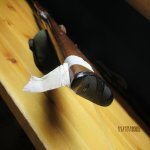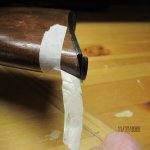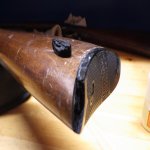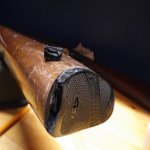- Location
- Okanagan Valley B.C.
You are using an out of date browser. It may not display this or other websites correctly.
You should upgrade or use an alternative browser.
You should upgrade or use an alternative browser.
Stock Repair
- Thread starter skwerl
- Start date
I would epoxy the wood, I would epoxy the pad but not to the wood, I would place a layer of packing tape between the pad and the but stock so the pad doesn’t stick to the wood, that way when you epoxy the pad it will be in the right shape! If it make sense?!
I would not use epoxy.
Rub yellow carpenter's glue into the crack in the stock while flexing the crack. You should be able to work glue throughout the crack by doing that. Wipe off excess on the exterior with a barely damp cloth and wrap with a piece of surgical tape or, if you are cheap like me, a 1/2" wide strip of inner tube. I am not sure what would be best for the plastic, but doubt it would be epoxy. One of the cyanoacrylates (Krazy Glue) or a glue made specifically for plastic would likely be best. Start by putting a good coat of paste wax on the end of the (now repaired) butt and you won't have to use a barrier such as tape.
Rub yellow carpenter's glue into the crack in the stock while flexing the crack. You should be able to work glue throughout the crack by doing that. Wipe off excess on the exterior with a barely damp cloth and wrap with a piece of surgical tape or, if you are cheap like me, a 1/2" wide strip of inner tube. I am not sure what would be best for the plastic, but doubt it would be epoxy. One of the cyanoacrylates (Krazy Glue) or a glue made specifically for plastic would likely be best. Start by putting a good coat of paste wax on the end of the (now repaired) butt and you won't have to use a barrier such as tape.
gunrunner100
CGN Ultra frequent flyer
- Location
- NW Ontario
Good advice on the wood. I have used Acra-Glas for wood repairs and for butt plates too. What I've done is drill holes in the fresh break of both sides of the butt plate, opposite of each other. Mix up some epoxy, preferably with a black dye and fill the holes and paint the fresh break sparingly. Clamp or brace it. When dry, the holes will create a mechanical lock for the dried epoxy. If you're accurate, you can even use pins in the holes for added strength. Of course, a release agent of some kind if you're using the stock as a pattern/jig. If not, let it dry on wax paper.
- Location
- Okanagan Valley B.C.
Unless this firearm has some collector value cut the stock 'flat' replace the plastic with a pad... either a recoil pad or a thin butt pad. If it had that to start with, the stock would never have been damaged...
Yep , it does..
- Location
- Blaster land, Okanagan BC
Titebond or some other type of wood glue for the stock crack, the butt plate I’d probably look for a replacement. Gluing plastic can be a failure waiting to happen I find.
Titebond for the wood 100%
The plastic is gonna be a lot tougher. CA won't hold up to even mild bumps, epoxy will for a little longer but will fail eventually.
If it's a plastic plate, I would be looking for a "hot" glue - PVC pipe glue comes to mind.
I would (try it on a similar or hidden spot first) probably glue it back edge to edge with super thin CA glue then relieve the inside enough to get a strip of polystyrene across the crack, probably a good idea to Dremel out the crack a little as well (like if you were welding something) then PVC it with the strip of polystyrene so that you have a lot more surface area for the bond and not just edge to edge.
You might also get away with the same approach but using fiberglass cloth. (and epoxy)
The challenge here is the edge to edge joint does not have a lot of surface area.
Of course if it's bakalite ... you'll need a new one
The plastic is gonna be a lot tougher. CA won't hold up to even mild bumps, epoxy will for a little longer but will fail eventually.
If it's a plastic plate, I would be looking for a "hot" glue - PVC pipe glue comes to mind.
I would (try it on a similar or hidden spot first) probably glue it back edge to edge with super thin CA glue then relieve the inside enough to get a strip of polystyrene across the crack, probably a good idea to Dremel out the crack a little as well (like if you were welding something) then PVC it with the strip of polystyrene so that you have a lot more surface area for the bond and not just edge to edge.
You might also get away with the same approach but using fiberglass cloth. (and epoxy)
The challenge here is the edge to edge joint does not have a lot of surface area.
Of course if it's bakalite ... you'll need a new one
I think sean69 has hit on something.
That plate could well be made of either a PVC or an ABS material. I lean toward ABS. The OP might put a drop of each - PVC cement and ABS cement on the centre back of the plate to see if either softens the plastic. If one of them does, that is likely the best adhesive for the job. There is also a transition cement, but I don't think it works as well as the correct cement for the material.
That plate could well be made of either a PVC or an ABS material. I lean toward ABS. The OP might put a drop of each - PVC cement and ABS cement on the centre back of the plate to see if either softens the plastic. If one of them does, that is likely the best adhesive for the job. There is also a transition cement, but I don't think it works as well as the correct cement for the material.
I think sean69 has hit on something.
That plate could well be made of either a PVC or an ABS material. I lean toward ABS. The OP might put a drop of each - PVC cement and ABS cement on the centre back of the plate to see if either softens the plastic. If one of them does, that is likely the best adhesive for the job. There is also a transition cement, but I don't think it works as well as the correct cement for the material.
I suppose if it does work, you could also use a rasp to get some shavings off a PVC pipe scrap (cuz lets face it we all have PVC scraps laying about that might be "useful" one day) to use a filler material?
Well, I know I have lots of ABS and PVC scrap lying around, but those amongst is who are less frugal could always trot down to the local hardware store to buy a fitting. In all seriousness, I don't see a need for filler material and I doubt it is PVC. My money is on ABS which, amongst other things, is less prone to distortion due to heat.
That stock is an EASY fix. Why replace it?
That stock is an EASY fix. Why replace it?
Titebond or some other type of wood glue for the stock crack, the butt plate I’d probably look for a replacement. Gluing plastic can be a failure waiting to happen I find.
Yes!! Titebond actually out preforms most epoxies for wood to wood applications.
- Location
- Okanagan Valley B.C.
Hy guys , I got the wood stock alright .
The butt pad is 120 year old (rubber ) 1899.
There in lies my conundrum , finding a replacement (which fits)
is a challenge .
What can bond a butt pad , it will not be taking any recoil
it is on a .22 .
Hiding the repair is key .
... skwerl
The butt pad is 120 year old (rubber ) 1899.
There in lies my conundrum , finding a replacement (which fits)
is a challenge .
What can bond a butt pad , it will not be taking any recoil
it is on a .22 .
Hiding the repair is key .
... skwerl
OK, so much for PVC, ABS or any of the other modern plastics.
I have difficulty believing it is actually rubber - more likely bakelite or some other period synthetic. Can you post a clear pic of the break? Is the surface smooth or rough/porous? Is there chipping around the edges (would point to bakelite)? The surface texture of the break will have a strong influence in determining the best way to effect a repair.
Bakelite was invented in 1907 so, if the rifle dates to about 1908 or earlier, we can rule out bakelite.
EDIT
I did a quick internet search on pre-1900 synthetics and suspect the buttplate might be made of gutta percha (rubber-based, used in some early Smith & Wesson grips & likely best bet), celluloid or one of the shellac-based products that early gramophone records were made of (brittle). I believe Locktite Black Max #380 might be the best adhesive for gutta percha. It is also black, so least likely to show.
Spend a little time researching on the net.
I have difficulty believing it is actually rubber - more likely bakelite or some other period synthetic. Can you post a clear pic of the break? Is the surface smooth or rough/porous? Is there chipping around the edges (would point to bakelite)? The surface texture of the break will have a strong influence in determining the best way to effect a repair.
Bakelite was invented in 1907 so, if the rifle dates to about 1908 or earlier, we can rule out bakelite.
EDIT
I did a quick internet search on pre-1900 synthetics and suspect the buttplate might be made of gutta percha (rubber-based, used in some early Smith & Wesson grips & likely best bet), celluloid or one of the shellac-based products that early gramophone records were made of (brittle). I believe Locktite Black Max #380 might be the best adhesive for gutta percha. It is also black, so least likely to show.
Spend a little time researching on the net.
Last edited:
I believe Locktite Black Max #380 might be the best adhesive for gutta percha. It is also black, so least likely to show.
Locktite Black Max will glue just about anything... it's a hell of an adhesive...
- Location
- Okanagan Valley B.C.
Locktite Black Max will glue just about anything... it's a hell of an adhesive...
The black Crazy Glue or Locktite sounds like the answer/.
I have some Gorilla glue but I'm really hesitant , too much
phukn marketing .
The stock chip repair isn't what I would like , a clean up
and some oil may help.
thnkz .. mojo / guntech
Attachments
What follows is how I would tackle it:
You appear to have quite a bit of tape or glue residue on the stock. Did you put a release agent such as paste wax on the stock prior to gluing? The glue doesn't usually bond tightly to the finish and can likely be picked or pushed off. How do the edges of the break feel? If they feel smooth, you should be able to touch up the edges of the break with some light walnut stain and then touch up the finish with a bit of Truoil or Linspeed (if you can find it). If they are raised, you might be able to to smooth the edges by lightly burnishing with something like the side of a chrome plated screwdriver. Whatever you use, make sure it is dead smooth and don't use so much pressure that you dent the wood.
That break in the plate is pretty much what I would want to see if it were mine and it was broken. It is V shaped, which should help with alignment, and there is a lot of surface area for the glue to bond to. I would start by removing the plate, cleaning up the end of the stock and applying a heavy coat of paste wax. The break is jagged, but looks like a clean break. Try not to dislodge any slivers or disturb anything. Put the plate back on the butt and test fit the pieces. You are good to go if the fit is good. If something is holding the pieces apart, it is likely a dislodged sliver. You will need to find and remove it or them. Dental picks work well here. You are ready to glue when the parts fit well. Make sure you know how you are going to clamp it before gluing. Don't cheap out on the glue. Do your research and choose the best adhesive for the material. Based on my BRIEF research, Locktite # 380 appears to be a good choice for gutta percha.
Hope this helps
You appear to have quite a bit of tape or glue residue on the stock. Did you put a release agent such as paste wax on the stock prior to gluing? The glue doesn't usually bond tightly to the finish and can likely be picked or pushed off. How do the edges of the break feel? If they feel smooth, you should be able to touch up the edges of the break with some light walnut stain and then touch up the finish with a bit of Truoil or Linspeed (if you can find it). If they are raised, you might be able to to smooth the edges by lightly burnishing with something like the side of a chrome plated screwdriver. Whatever you use, make sure it is dead smooth and don't use so much pressure that you dent the wood.
That break in the plate is pretty much what I would want to see if it were mine and it was broken. It is V shaped, which should help with alignment, and there is a lot of surface area for the glue to bond to. I would start by removing the plate, cleaning up the end of the stock and applying a heavy coat of paste wax. The break is jagged, but looks like a clean break. Try not to dislodge any slivers or disturb anything. Put the plate back on the butt and test fit the pieces. You are good to go if the fit is good. If something is holding the pieces apart, it is likely a dislodged sliver. You will need to find and remove it or them. Dental picks work well here. You are ready to glue when the parts fit well. Make sure you know how you are going to clamp it before gluing. Don't cheap out on the glue. Do your research and choose the best adhesive for the material. Based on my BRIEF research, Locktite # 380 appears to be a good choice for gutta percha.
Hope this helps
Last edited:










































































